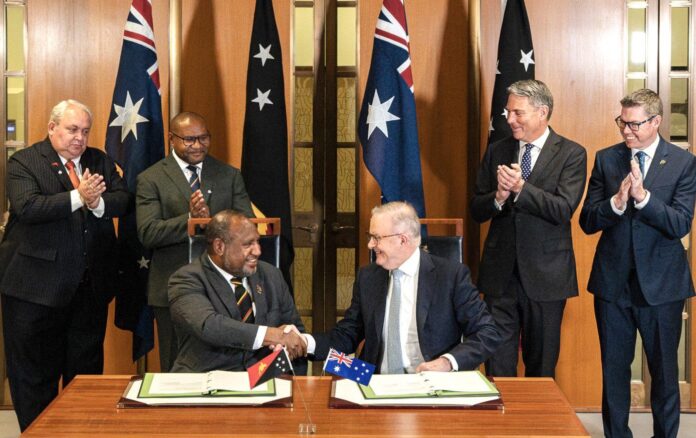
By Joe Keary and Mike Hughes*
Debate over the Pukpuk treaty has focused on China and whether Australia’s military might one day use Papua New Guinea’s geography or fight alongside PNG forces in a regional contingency involving Beijing and Washington. But this lens distorts what the agreement is most likely to deliver. (The Strategist. The Australian Strategic Policy Institute.)
China’s growing profile in the Pacific has shaped much of the context. Since reports in 2018 that Beijing had explored the possibility of establishing a military facility in Vanuatu, Canberra has redoubled the diplomatic, defence and development engagement it committed to in its 2016 Pacific ‘step-up’.
The concern is not unfounded: Beijing has sought influence through infrastructure, policing agreements and access arrangements that could, over time, enable a more permanent military presence in the region.
Against this backdrop, the Pukpuk Treaty fits within Australia’s effort to ensure the Pacific remains stable and sovereign. Yet viewing it exclusively as a counter-China initiative overlooks its deeper significance.
The treaty is Australia’s first formal defence alliance in more than half a century, and it reflects the unique nature of Canberra’s relationship with Port Moresby. PNG is a young state facing considerable internal security pressures, from disaster response to law-and-order challenges, where Australian assistance has long been critical. In 2018, the Australian Defence Force deployed aircraft and personnel to support relief efforts following a devastating earthquake in PNG’s Highlands region that killed more than 160 people. That same year, Australia provided close security support for Port Moresby’s hosting of the APEC Summit.
PNG has shown that it too can lend a hand. In January 2020, it dispatched a contingent of 100 engineers to help Australia during catastrophic bushfires. The two countries have also partnered in regional missions, including a joint role in the Regional Assistance Mission to Solomon Islands beginning in 2003, as well as more recent deployments to assist Honiara during civil unrest in 2021 and in preparation for the 2023 Pacific Games. These cases highlight the pattern the treaty is designed to formalise: two neighbours providing mutual support in moments of need and working together to sustain regional stability.
The treaty’s text commits the partners to ‘secure mutual defence and security interests and contribute to regional stability and security,’ while underscoring the principle of sovereignty. This record of cooperation offers a strong indication of what to expect.
Australia and PNG will also remain attentive to Indonesia’s sensitivities, and it is highly unlikely that the agreement will result in ADF activity near Indonesia’s border. Canberra, always conscious of Indonesia’s interests, will be using all avenues of diplomacy to reassure Jakarta and reinforce that the treaty is positive for regional stability.
The document also pledges to ‘strengthen and expand defence cooperation through enhanced capability, interoperability, and integration.’ For PNG, that ambition is already visible. Its participation in the 2025 Talisman Sabre exercise, Australia’s largest multinational exercise, was a significant milestone. On a day-to-day basis, the Defence Cooperation Program sustains hundreds of engagements each year, embedding a network of training, advisory and operational ties. Scope for mutual recruitment pathways is a clever mechanism to not only address Australia’s recruitment shortfalls, but also to invest in PNG personnel who can one day return to play a bigger role in nation-building efforts.
PNG Prime Minister James Marape has detailed his aspirations for the PNG Defence Force: an expansion to 7,000 personnel, including new battalions in the Highlands region; a revived maritime capability to secure PNG’s extensive waters; and the establishment of an air wing capable of operating across some of the most challenging terrain in the region. The Pukpuk Treaty provides a framework for Australia to help PNG meet these goals—ambitions that are measured and realistic for a country confronting severe security pressures at home and in its neighbourhood.
Speculation about Australian bases in PNG remains premature. Marape has been careful not to commit to such an arrangement at this time, though the idea should not be ruled out entirely. PNG’s geography has enduring strategic weight: Manus Island and the northern coastline host facilities that could, in time, support joint operations.
In a regional crisis involving China, the United States would be the only actor able to match Beijing’s military scale, but Australia would have a pivotal role in protecting sea lanes and denying unfettered Chinese access to the Pacific. PNG’s geography could prove critical in that context, though always under Port Moresby’s terms.
The Pukpuk Treaty is therefore less about aligning PNG against China and more about formalising a partnership that has already proved resilient. It locks in habits of cooperation, creates pathways for PNG to professionalise and expand its defence force, and signals that Australia views its closest neighbour not just as a recipient of aid, but as a partner in shaping Pacific security.
*Joe Keary is a senior analyst and Mike Hughes is director of ASPI’s Defence Strategy program.



